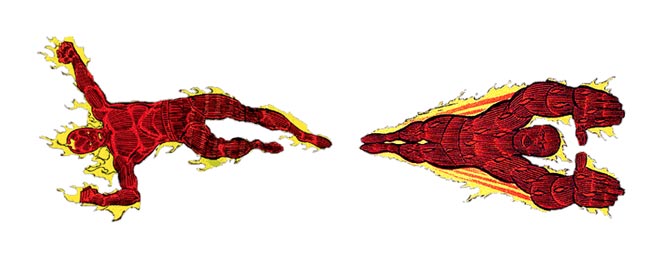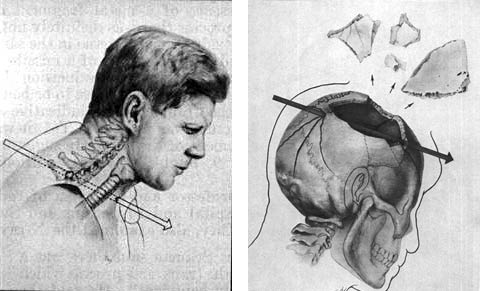flashback

Researchers have shown that by becoming carnivores, our ancestors were able to give birth to a greater number of offspring.
“Eating meat enabled the breast-feeding periods to be reduced and thereby the time between births to be shortened,” said lead author Elia Psouni from Lund University in Sweden. “This must have had a crucial impact on human evolution.”
Past research has tried to explain the relatively short breast-feeding period of humans based on social and behavioral theories of parenting and family size. For an average human baby, the duration of breast-feeding is two years and four months. This is not long in relation to the maximum lifespan of our species - around 120 years. It is even less if compared to our closest relatives - female chimpanzees suckle their young for four to five years, whereas the maximum lifespan for chimpanzees is only 60 years.
{ Cosmos | Continue reading }
flashback, food, drinks, restaurants, kids, science | April 24th, 2012 12:19 pm

Large eggs must have thick shells, which make it difficult for the developing embryo to ‘breathe’ by exchanging gases with the outside world. This places an upper limit on egg size.
So, even though they grew into giants as adults, dinosaurs were forced to produce relatively tiny young. Titanosaur hatchlings, for example, were nearly 2,500 times smaller than the 4-tonne adults. By contrast, the live-born calf of an Asian elephant (Elephas maximus) is about 25 times smaller than its mother.
When the young of large animals start out small, they must grow through a large size range before reaching adulthood, and compete with species of many different sizes as they do so.
Codron and his colleagues developed a model that suggests that there was intense competition among small and medium-sized dinosaurs, so that it was difficult for medium-sized adults to make a living, and adults had to keep growing until they reached very large sizes to gain a competitive edge.
But being big also has drawbacks. When an asteroid impact at the end of the Cretaceous period (65 million years ago) wiped out most large-bodied animals, there were so few small dinosaur species that the group was almost obliterated, with only the birds surviving. However, the many small mammals alive at the time were well suited to a world that favored diminutive species.
{ Nature | Continue reading }
animals, flashback, science | April 19th, 2012 10:27 am

Victorian-era doctors disliked dealing with female patients. This highly masculinized profession saw women as overly emotional and barely capable of rational discussion of their bodies. (…)
One of women’s most common medical conditions was broadly called “hysteria.” By this, doctors meant any number of symptoms that described “irrational” female complaints. (…)
Male doctors found their hysterical and neurasthenic patients especially frustrating. Many doctors suggested that women would feel better if they engaged in sexual intercourse until its natural conclusion with a male orgasm. But given the ineffectiveness of vaginal penetration in satisfying many women, doctors resorted to other solutions. Doctors manually massaged the women’s clitoris until she achieved relief, i.e. experienced an orgasm, although it was not recognized as such. Annoyed doctors complained that it took women forever to achieve this relief; moreover, they thought this condition beneath their respectable professional demeanor to treat. On the other hand, the repeat business of these women was good for their pocketbooks.
Beginning in 1869, inventors developed steam-powered massage machines for medical offices. By 1900, doctors had a wide variety of devices to choose from, helping relieve the tedium of digitally massaging female patients. Even better from medical professionals’ perspective was the invention of a hand-held vibrator in 1905, allowing women to treat their own hysteria without visiting a physician. Soon, companies began advertising for the home vibrators.
{ AlterNet | Continue reading }
photo { Richard Kern }
flashback, sex-oriented | April 13th, 2012 12:14 pm

For decades in art circles it was either a rumor or a joke, but now it is confirmed as a fact. The Central Intelligence Agency used American modern art - including the works of such artists as Jackson Pollock, Robert Motherwell, Willem de Kooning and Mark Rothko - as a weapon in the Cold War. In the manner of a Renaissance prince - except that it acted secretly - the CIA fostered and promoted American Abstract Expressionist painting around the world for more than 20 years. (…)
Why did the CIA support them? Because in the propaganda war with the Soviet Union, this new artistic movement could be held up as proof of the creativity, the intellectual freedom, and the cultural power of the US. Russian art, strapped into the communist ideological straitjacket, could not compete.
{ Independent | Continue reading }
photo { Jackson Pollock, Clement Greenberg, Helen Frankenthaler, Lee Krasner and an unidentified child at the beach, 1952 }
U.S., art, flashback, rothko, spy & security | April 5th, 2012 5:20 pm

Some of the memories that stick with me from that era:
—Our top account executive was sleeping with a creative director, a copywriter (not me), an account supervisor, and, I believe, the married CEO of the firm, all at the same time. She later became president of the agency.
—After 5pm, said CEO would walk around the office rambling about “big ideas” while smoking a fat joint laced with cocaine and who knows what else. (He’s been dead for five years). Often accompanying him on the tours was his best friend, a boxer/mob hitman with hair plugs, who casually told us about his kills.
—Our New Business guy, not the sharpest X-Acto knife in the drawer, got us in a lot of doors. He then died of a cocaine overdose in the CEO’s pied-à-terre fuckpad.
{ Copyranter/Buzzfeed | Continue reading }
artwork { David Mann }
experience, flashback, marketing, new york | April 3rd, 2012 7:12 am

New findings at the Wonderwerk Cave, in South Africa, suggest that early humans started using fire 1 million years ago, approximately 300,000 years earlier than previously thought.
{ United Academics | Continue reading }
fire, flashback, science | April 3rd, 2012 7:12 am

We are still living under the reign of logic: this, of course, is what I have been driving at. But in this day and age logical methods are applicable only to solving problems of secondary interest. The absolute rationalism that is still in vogue allows us to consider only facts relating directly to our experience. Logical ends, on the contrary, escape us. It is pointless to add that experience itself has found itself increasingly circumscribed. It paces back and forth in a cage from which it is more and more difficult to make it emerge. It too leans for support on what is most immediately expedient, and it is protected by the sentinels of common sense. Under the pretense of civilization and progress, we have managed to banish from the mind everything that may rightly or wrongly be termed superstition, or fancy; forbidden is any kind of search for truth which is not in conformance with accepted practices. It was, apparently, by pure chance that a part of our mental world which we pretended not to be concerned with any longer — and, in my opinion by far the most important part — has been brought back to light. For this we must give thanks to the discoveries of Sigmund Freud. On the basis of these discoveries a current of opinion is finally forming by means of which the human explorer will be able to carry his investigation much further, authorized as he will henceforth be not to confine himself solely to the most summary realities.
{ André Breton, Manifesto of Surrealism, 1924 | Continue reading }
Surrealism had the longest tenure of any avant-garde movement, and its members were arguably the most “political.” It emerged on the heels of World War I, when André Breton founded his first journal, Literature, and brought together a number of figures who had mostly come to know each other during the war years. They included Louis Aragon, Marc Chagall, Marcel Duchamp, Paul Eluard, Max Ernst, René Magritte, Francis Picabia, Pablo Picasso, Phillippe Soupault, Yves Tanguey, and Tristan Tzara. Some were “absolute” surrealists and others were merely associated with the movement, which lasted into the 1950s. (…)
André Breton was its leading light, and he offered what might be termed the master narrative of the movement.
No other modernist trend had a theorist as intellectually sophisticated or an organizer quite as talented as Breton. No other was [as] international in its reach and as total in its confrontation with reality. No other [fused] psychoanalysis and proletarian revolution. No other was so blatant in its embrace of free association and “automatic writing.” No other would so use the audience to complete the work of art. There was no looking back to the past, as with the expressionists, and little of the macho rhetoric of the futurists. Surrealists prized individualism and rebellion—and no other movement would prove so commercially successful in promoting its luminaries. The surrealists wanted to change the world, and they did. At the same time, however, the world changed them. The question is whether their aesthetic outlook and cultural production were decisive in shaping their political worldview—or whether, beyond the inflated philosophical claims and ongoing esoteric qualifications, the connection between them is more indirect and elusive.
Surrealism was fueled by a romantic impulse. It emphasized the new against the dictates of tradition, the intensity of lived experience against passive contemplation, subjectivity against the consensually real, and the imagination against the instrumentally rational. Solidarity was understood as an inner bond with the oppressed.
{ Logos | Continue reading }
flashback, ideas, poetry | March 28th, 2012 6:12 am

The pubic louse evolved around 3.3 million years ago, and it could not have done so until ancestral humans lost their body fur, creating its niche. What’s more, [we have] dated the evolution of body lice, which live in clothing, to around 70,000 years ago. So it looks like our ancestors wandered around stark naked for a very long time.
{ NewScientist via | Overcoming Bias | Continue reading }
photo { Helmut Newton, Nu dans les algues, Saint-Tropez, 1981 }
flashback, science | March 27th, 2012 10:02 am

Absinthe, a bitter spirit containing wormwood (Artemisia absinthium L.), was banned at the beginning of the 20th century as consequence of its supposed unique adverse effects. After nearly century- long prohibition, absinthe has seen a resurgence after recent de-restriction in many European countries. This review provides information on the history of absinthe and one of its constituent, thujone. Medical and toxicological aspects experienced and discovered before the prohibition of absinthe are discussed in detail, along with their impact on the current situation. The only consistent conclusion that can be drawn from those 19th century studies about absinthism is that wormwood oil but not absinthe is a potent agent to cause seizures. Neither can it be concluded that the beverage itself was epileptogenic nor that the so-called absinthism can exactly be distinguished as a distinct syndrome from chronic alcoholism.
The theory of a previous gross overestimation of the thujone content of absinthe may have been verified by a number of independent studies. Based on the current available evidence, thujone concentrations of both pre-ban and modern absinthes may not have been able to cause detrimental health effects other than those encountered in common alcoholism. Today, a questionable tendency of absinthe manufacturers can be ascertained that use the ancient theories of absinthism as a targeted marketing strategy to bring absinthe into the spheres of a legal drug-of-abuse. Misleading advertisements of aphrodisiac or psychotropic effects of absinthe try to re-establish absinthe’s former reputation.
{ Substance Abuse Treatment, Prevention, and Policy | Continue Reading | Read more/via: A bouquet from Mendel }
flashback, food, drinks, restaurants, health | March 27th, 2012 7:15 am
flashback, science, visual design | March 23rd, 2012 11:24 am

{ 1. Medical drawing of a cross-section of President Kennedy’s neck and chest, showing the trajectory of the projectile from back to throat. | 2. Diagram showing the trajectory of the missile through President Kennedy’s skull. The skull fragments are shown exploded for illustrative purposes; most stayed attached to the skull by skin flaps. | John F. Kennedy autopsy | Wikipedia }
U.S., flashback, science | March 22nd, 2012 7:20 am

Alexander Shulgin, the chemist who re-discovered MDMA (after it was synthesised and abandoned by Merck) and went on to discover hundreds of psychedelic drugs such as the 2C* family. He is famous not only for independently discovering and developing so many psychedelics but for testing them extensively on himself and for writing the core textbooks of the psychedelic literature, PiHKAL (‘Phenethylamines I Have Known and Loved’) and TiHKAL (‘Tryptamines I Have Known and Loved).
{ Neurobonkers | Continue reading }
drugs, flashback | March 20th, 2012 12:00 pm
architecture, flashback | March 19th, 2012 3:00 pm

Eating people is wrong. But why? People of different sorts, at different times, expressing their views in different idioms, have had different answers to that question. Right now, our culture isn’t obsessed with cannibalism, though we are still unwholesomely fascinated enough to buy books and go to movies about anthropophagy among the Uruguayan rugby team that ran out of food after their plane crashed in the Andes. (…)
Our modern idioms for disapproving of cannibalism are limited. There is a physical disgust at the very idea of eating human flesh, though it’s not clear that this is necessarily different from the revulsion felt by some people confronted with haggis, calf brains, monkfish liver, or sheep eyes, the rejection of which rarely requires, or receives, much of an explanation. It is widely thought that cannibalism is in itself a crime, but in most jurisdictions it isn’t. (It is criminal to abuse a corpse, so eating dead human flesh tends to be swept up under statutes mainly intended to prevent trading in human body parts or mutilating cadavers.)
{ LA Review of Books | Continue reading }
artwork { Keith Haring }
flashback, food, drinks, restaurants, gross | March 12th, 2012 2:00 pm

Epicurus himself, while dismissive of the claims of all religions, was no “luxurious sensualist.” Known for the simplicity of his life, he was born on the Greek island of Samos in 341 BCE, studied philosophy in Athens with a disciple of Plato’s and eventually founded a school of his own there, over which he presided until his death, in 270. Breaking with the Idealism of Plato, his thought, influenced by the Atomism of Democritus, was thoroughly materialistic in its description of the universe and — though its starting point was quite different — similar in many of its conclusions to that of the Stoics. The physical world, he held, was all there was and was composed of differently shaped atoms whose various combinations formed all matter; there were no divine laws or divine rewards or punishments for human actions, and hence no moral codes that human beings were obliged to obey. The only rational goal was to live life as pleasurably as possible.
And yet, Epicurus wrote: “When we say that pleasure is the end and aim, we do not mean the pleasures of the prodigal or the pleasures of sensuality, as we are understood to do by some through ignorance, prejudice or willful misrepresentation. By pleasure we mean the absence of pain in the body and of trouble in the soul. It is not an unbroken succession of drinking bouts and of revelry, not sexual lust, not the enjoyment of the delicacies of a luxurious table, which produce a pleasant life…. We cannot live pleasantly without living wisely, honorably, and justly, nor live wisely, honorably, and justly without living pleasantly.”
{ The Jewish Daily Forward | Continue reading }
flashback, ideas | February 29th, 2012 3:07 pm

Chang and Eng Bunker were conjoined twin brothers, born on May 11, 1811 in Siam (now Thailand). Their condition and birthplace became the basis for the term “Siamese twins.”
Because of their Chinese heritage (as they were born from a Thai Chinese father and Chinese-Malay mother), they were known as the “Chinese Twins” in Siam. They were joined at the sternum by a small piece of cartilage. Their livers were fused but independently complete. Although 19th century medicine did not have the means to do so, modern surgical techniques would have easily allowed them to be separated.
In 1829, they were “discovered” in Siam by British merchant Robert Hunter and exhibited as a curiosity during a world tour. Upon termination of their contract with their discoverer, they successfully went into business for themselves. In 1839, while visiting Wilkesboro, North Carolina, the twins were attracted to the area and settled on a 110-acre farm in nearby Traphill, becoming naturalized United States citizens.
Determined to start living a normal life as much as possible, the brothers settled on a plantation, bought slaves, and adopted the name “Bunker.”
On April 13, 1843, they married two sisters: Chang to Adelaide Yates and Eng to Sarah Anne Yates. This made their respective children double first cousins. In addition, because Chang and Eng were identical twins, their children were genetically equivalent to half-siblings, thus making them genetically related in the same manner as half-siblings who are also first cousins.
Their Traphill home is where they shared a bed built for four. Chang and his wife had 10 children; Eng and his wife had 11. In time, the wives squabbled and eventually two separate households were set up – the twins would alternate spending three days at each home. During the American Civil War Chang’s son Christopher and Eng’s son Stephen both fought for the Confederacy. Chang and Eng lost part of their property as a result of the war, and were very bitter in their denunciation of the government in consequence.
After the war, they again resorted to public exhibitions, but were not very successful. They always maintained a high character for integrity and fair dealing, and were much esteemed by their neighbors. The twins died on the same day in January 1874. Chang, who had contracted pneumonia, died rather suddenly in his sleep. Eng awoke to find his brother dead, and called for his wife and children to attend to him. A doctor was summoned to perform an emergency separation, but Eng refused to be separated from his dead brother. He died three hours later.
{ Wikipedia | Continue reading | Thanks Tim }
flashback | February 28th, 2012 11:25 am

May 31, 1884: John Harvey Kellogg patents flaked cereal. (…) He was highly incensed by masturbation and campaigned zealously, if not rabidly, for its discontinuation. He warned that masturbation caused acne and recommended the “treatment” of carbolic acid on the clitoris in order to stop females from participating in the unsavory practice. Carbolic acid is very dangerous when applied to skin.
{ Little Bits of History | Continue reading | Wikipedia }
photo { Steven Meisel }
flashback, sex-oriented, weirdos | February 22nd, 2012 4:09 pm

On March 14, 1932, Eastman died by suicide with a single gunshot to the heart, leaving a note which read, “To my friends: my work is done. Why wait?”
{ Wikipedia | Continue reading }
photo { Gregory Crewdson }
flashback, photogs | February 9th, 2012 4:35 pm

In 1925, Benito Mussolini initiated a campaign to destroy the Mafia and assert Fascist control over Sicilian life. (…) Mussolini appointed Cesare Mori as the Prefect of Palermo in October 1925 and granted him special powers to fight the Mafia. Mori formed a small army of policemen, carabinieri and militiamen, which went from town to town, rounding up suspects. To force suspects to surrender, they would take their families hostage, sell off their property, or publicly slaughter their livestock. By 1928, over 11,000 suspects were arrested. Confessions were sometimes extracted through beatings and torture. Some mafiosi who had been on the losing end of Mafia feuds voluntarily cooperated with prosecutors, perhaps as a way of obtaining protection and revenge. (…)
Mori’s campaign ended in June 1929 when Mussolini recalled him to Rome. Although he did not permanently crush the Mafia as the Fascist press proclaimed, his campaign was nonetheless very successful at suppressing it. As the Mafia informant Antonino Calderone reminisced: “After the war the mafia hardly existed anymore. The Sicilian Families had all been broken up.”
Sicily’s murder rate sharply declined. Many mafiosi fled to the United States. Among these were Carlo Gambino and Joseph Bonanno, who would go on to become powerful Mafia bosses in New York City.
{ Wikipedia | Continue reading }
flashback | January 27th, 2012 9:05 am

[Princess Marie Bonaparte] suffered from what many women today still do – the inability to reach orgasm solely through vaginal intercourse. Defying the social mores of her era, she discovered she could reach orgasm through masturbation. (…)
She first examined and interviewed 243 women. One by one she measured the distance between their clitorises and the vaginas, then compared the distance to their frequency and ease of orgasm. What she discovered was a direct correlation between the ability to orgasm through vaginal sex and the measurement of space between the vagina and the external part of the clitoris. She categorized the findings from her subjects in three ways: paraclitoridiennes (para meaning “alongside”), mesoclitoriennes (meso meaning “in the middle”), and téléclitoridiennes (télé meaning “far”).
Paraclitoridiennes were the fortunate ones. The space between their vaginas and clitorises measured less than one inch. For the 69% of her test subjects that fell into this category, vaginal orgasm was easier than ever to reach. However, similar studies conducted in modern times prove this statistic extremely high.
{ Mosex | Continue reading }
more { A complete breakthrough that explains how what we once considered to be a vaginal orgasm is actually an internal clitoral orgasm. }
flashback, science, sex-oriented | January 19th, 2012 10:44 am
























